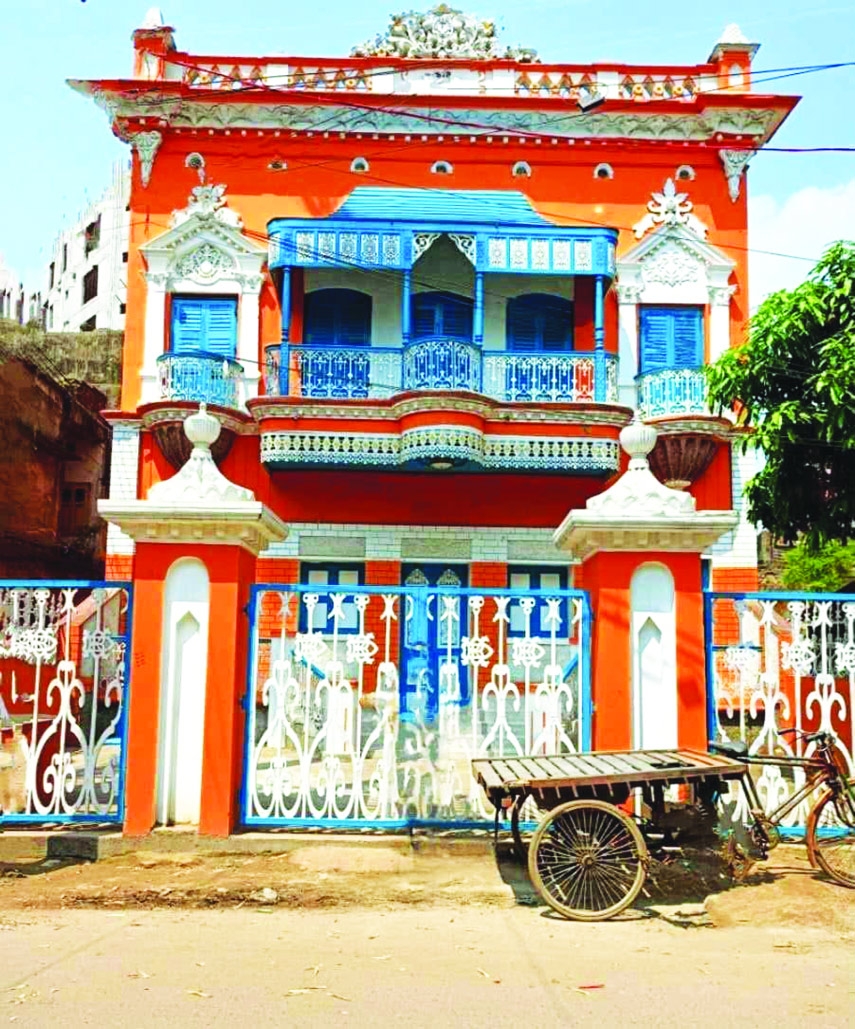Published: 12:00 AM, 19 November 2025
The French Footprint in Farashganj and the Story of Laxmi Villa

In a city where many archaeological and heritage structures have fallen victim to careless encroachment and neglect, Laxmi Villa in Dhaka’s Farashganj stands as a fortunate exception. Located on BK Das Lane in old Dhaka's Farashganj, this elegant mansion was built in 1911 by Basanta Kumar Das, a wealthy businessman and social worker of the time.
Wandering the narrow streets of Farashganj, you can still find traces of a bygone Dhaka — whispers of a time when the neighborhood was home to wealthy merchants, elegant mansions, and the vibrant hum of old trade routes.
The French Legacy in Dhaka: The Story of Farashganj
Historical observation shows that Old Dhaka was once a well-planned, beautiful, and orderly city built around the lifeline of the Buriganga River. Along its banks grew several ganjs (trading quarters), which together laid the foundation of what we now know as Old Dhaka. The city once radiated nobility and grandeur, its lanes alive with the elegance of Mughal architecture and mercantile wealth.
The French Legacy in Dhaka: The Story of Farashganj
Historical observation shows that Old Dhaka was once a well-planned, beautiful, and orderly city built around the lifeline of the Buriganga River. Along its banks grew several ganjs (trading quarters), which together laid the foundation of what we now know as Old Dhaka. The city once radiated nobility and grandeur, its lanes alive with the elegance of Mughal architecture and mercantile wealth.
However, with the fall of the Mughal rulers, the fortune of Old Dhaka began to wane. Though the British administration later extended some attention to the city’s upkeep, modern neglect has gradually eroded its past glory. The remnants of its once-glorious past now stand as silent witnesses to a forgotten heritage.
Among these heritage-rich neighborhoods lies Farashganj, a place with a fascinating past.
Among these heritage-rich neighborhoods lies Farashganj, a place with a fascinating past.
According to historians, the last of the European merchants to arrive in the Indian subcontinent were the French. In 1664, during the reign of King Louis XIV, the French East India Company was established through the efforts of his minister, Colbert. Just four years later, in 1668, under the leadership of François Caron, the French set up their first trading post in Surat, followed by another in Masulipatam the next year.
The French presence eventually spread eastward. In 1674, the Subedar of Bengal, Shaista Khan, granted permission to establish a trading post in Chandannagar, marking the beginning of French influence in Bengal.
According to Dhaka Kendra, the neighbourhood that still carries the memory of the French presence in the city is Farashganj—literally meaning “French locality.”
Long before the British East India Company set foot in Bengal, the French had already established a foothold in Dhaka. The neighborhood that still bears traces of their presence is Farashganj — literally “the French neighborhood.”
In 1682, a French fleet arrived in Dhaka, paving the way for the establishment of the French trading house, known as the French Kuthi. By 1690, M. Gregory served as the head of this French House. Later, in 1740, during the tenure of Nawazish Mohammad as Naib Nazim of Dhaka, the French received permission to set up a market along the banks of the Buriganga River—the place we now know as Farashganj—a name derived from Foras, the local term for “French,” and ganj, meaning “market.”
Farashganj is one such place where tales of merchants and trades are found. Farashganj is located on the northern bank of the Buriganga River (Old Ganges) in Old Dhaka. Its principal thoroughfares are B K Das Road and Ahsanullah Road, of the Old Town. Along with Shutrapur this is also known as one of the oldest roads.
The French also purchased several houses in the Waizghat area and had another trading post at the site where Ahsan Manzil now stands.
When Nawab Sirajuddaula seized the English factories in both Dhaka and Calcutta in 1756, several English officers — including Luke Screfton, Thomas Hyndman, and Samuel Waller — sought refuge in the French compound under the protection of Superintendent Monier Curtin. Despite this act of solidarity, the British later confiscated many French properties.
The French Kuthi was closed around 1774, and by 1778 it had passed into British hands. The renowned Armenian merchant Nicholas Peter Pogose later took the lease of Farashganj Bazar. During this period, both the market and the French trading community played a vital role in Dhaka’s economy, particularly through the wholesale trade of spices and the export of the city’s famed muslin fabric to foreign markets.
Over the following decades, the British repeatedly occupied French establishments — first in 1776, again in 1793, and finally in 1803 — with brief periods of return to French control. Besides their operations in Farashganj, the French also owned several buildings in Tejgaon. But with each successive British occupation, they were eventually forced to sell their Kuthi, the Farashganj market, and their Tejgaon properties.
Today, Farashganj stands as one of the few remaining reminders of Dhaka’s early cosmopolitan past — when the city was not just Mughal or British, but also unmistakably French.
Laxmi Villa: A Forgotten Gem of BK Das Lane and Farashganj
Laxmi Villa: A Forgotten Gem of BK Das Lane and Farashganj
The centuries-old structures of Old Dhaka still stand tall, silently bearing witness to the city’s rich culture and layered heritage. Among these proud survivors is Laxmi Villa—better known to locals as Basantbabu’s House—a graceful reminder of a bygone era.
Once upon a time, today’s Bangladesh was ruled by landlords, kings and nawabs. Though those figures have long faded into history, their legacy endures through the architectural gems scattered across the city. On B.K. Das Road in Farashganj, these historic mansions and ornate façades continue to whisper stories of opulence and grandeur.
Most of the once-aesthetic architectural wonders along BK Das Lane now lie in ruins. The names of these houses are as varied as their histories, yet no clear answer can be found from local residents about who their real owners or builders were.
The pitiful condition of these beautifully crafted structures reflects the government’s indifference. There is no historical research, no preservation effort—only neglect.
Since 2004, the Urban Study Group has been working to preserve the traditional houses of Old Dhaka. According to its head, Taimur Islam, one such house belonged to Basanta Kumar Das and was known as Lakshmi Villa. Basanta Kumar, a prosperous merchant dealing in bricks, wood, conch, and cloth, built this house in the early 20th century when his business flourished.
In 2019, writer Jenny Gustafson published an article in The Guardian about Lakshmi Villa, drawing on information from Taimur Islam. Her research shed further light on the history of the house and its owners.
According to the historians, built in 1918, Laxmi Villa stands as one of the most remarkable heritage houses in Farashganj. Its founder, Basanta Kumar Das, was a zamindar and a leading businessman of the locality, owning multiple properties in what is now B.K. Das Road — a street named after him. His brothers owned Nos. 45 and 46, while No. 47 passed to his son, Ajit Kumar Das, after his death.
The house was conceived not only as a residence but as a symbol of social and cultural life in early 20th-century Dhaka. The grand front entrance once opened into a business chamber where the owner-merchant met clients and conducted trade. Beyond this lay a splendid dance hall with a soaring ceiling and 15 chandeliers. It was here that evening soirées were hosted, featuring professional musicians and dancers. Male guests watched the performances from the ground floor, while the women of the household observed from two first-floor balconies overlooking the hall.
Above the dance hall, on the second floor, Ajit Babu built a vast billiard room named the Anupama Billiard Hall, after his mother. Legend has it that he once went to Dhaka Club to play snooker but found no table available — prompting him to construct his own hall and import a billiard table from England.
The house’s next chapter began in 1962. Following the communal violence of 1950, Barrister Asrarul Hossain — son of Shamsul Ulama Khan Bahadur Moulvi Mohammad Musa (RA), former principal of Calcutta Alia Madrasa — had moved with his family to East Pakistan. In 1962, he and Ajit Babu exchanged their paternal properties, after which Ajit Babu migrated to India and Barrister Hossain settled into Laxmi Villa.
The historic dance hall then took on a new role: it became the chamber where Barrister Hossain practiced law. Over the years, several of Bangladesh’s future legal luminaries worked under him here, including Barrister Rafiqul Huq — later Attorney General — as well as future Chief Justices M.H. Rahman and Latifur Rahman.
Barrister Hossain later acquired No. 46 from Ajit Babu’s cousin, Prafulla Kumar Das, in a sale deed witnessed by Barrister Rafiqul Huq and Advocate Latifur Rahman. He also built the present mosque on the site where Profullo Babu’s Boithok Khana once stood.
Today, the two properties are owned by King’s Counsel Mr. Ajmalul Hossain, and his brothers Altaful Hossain and Ashraful Hossain. In November 2022, under the direction of Barrister Hossain KC, restoration of Laxmi Villa began. The front elevation was revived within a month using original designs and colours, following the heritage-conservation “3R” principle: restore, repair, replace.
The Hossain family carries a distinguished legal legacy. Inspired by Barrister Asrarul Hossain, three of his grandchildren became barristers — all called to the Bar at Lincoln’s Inn in London — marking the first Bangladeshi family with three generations from the same honorable Society.
Laxmi Villa thus stands not only as a relic of the French-influenced architecture of old Farashganj and the legacy of the B.K. Das family, but also as a living testament to the Hossain family’s enduring contribution to the legal fabric of Bangladesh — a heritage that bridges two families, two eras, and more than a century of history.
Farashganj is not known only for its trade history. It was an embankment of a numerous historic buildings, most of which are now dilapidated. The buildings are derelict and are now abandoned palatial mansions.
The fate of our country’s archaeological monuments, so often doomed to careless and negligent encroachment, is indeed a tragic one. Yet among the few that have escaped this relentless tide stands an aesthetic relic — Laxmi Villa.
Not far from Laxmi Villa lies Shyambazar, believed to be the oldest market built on the banks of the Buriganga River. The bustle and spirit of trade that began centuries ago still survive here. What began in 1740 as a small ganj or marketplace established by French merchants during the time of Naib Nazim Nawazish Mohammad Khan has evolved into the thriving Shyambazar we know today.
From the intersection of Lalkuthi Ghat, the street unfolds into rows of vibrant shops along B.K. Das Road. Sacks of onions, garlic, ginger, dried chilies, turmeric, coriander, and potatoes line the pathways, while trucks rumble through, unloading fresh goods. Wander through the narrow alleys toward the riverside, and you’ll find clusters of humble vegetable stalls—living fragments of a city that has never stopped moving.
Adnan Hadi is a senior
journalist mainly
writing on archeological sites
and sports. He can be reached at: [email protected]
Adnan Hadi is a senior
journalist mainly
writing on archeological sites
and sports. He can be reached at: [email protected]



